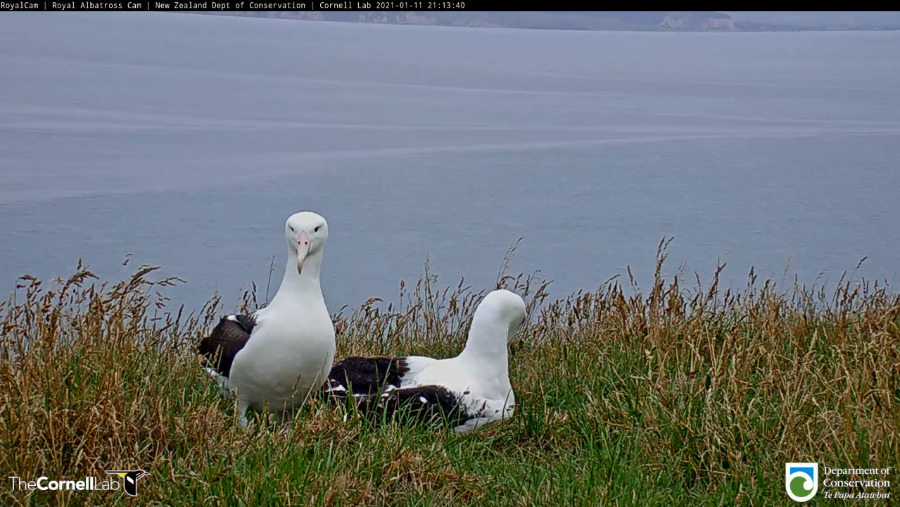Labdien!
Jauka diena,jo atgriezusies mammīte LGL
21.05
Kā parasti,atgriešanās tiek sajusta jau laicīgi

21.13

21.19

Sharyn Broni (Ranger, DOC)Sharyn Broni (Ranger, DOC)
Now that LGL has returned the egg can be returned from the incubator and the dummy egg removed.
At 67 days of age it is only another 5 or 6 days before we will look for signs of hatching. Early signs are the chick calling from within the shell and scrunching noises as the chicks bill rubs against the inner membrane of the aircell.
Once the chicks head is in the aircell the egg tooth of the end of the bill can crack open the shell. Once this happens we will be moving the egg back to the incubator for hatching.
All eggs will be hatched in the incubators to protect the hatching chick from fly strike. Fly strike happens when a fly lays eggs in the moist area of the hatching egg and the resulting maggots eat the flesh of the chick.
The chick will be returned to the nest during the cool part of the day as a day old chick. The nest will be sprayed with Avian Insect Liquidator to prevent flies from living in the nest. The chick will have this applied while still in the incubator room. The substance repels flies and is safe for use on birds.
The parents will be totally fine and accept the procedure of having a dummy egg then a chick. Fly strike is such a huge risk that these measures are necessary to ensure that as many chicks as possible survive.

 1.12.21
1.12.21Sharyn Broni (Ranger, DOC)Sharyn Broni (Ranger, DOC)
Kia ora koutou (hello everyone)
Visual checking for hatching has started and two eggs are hatching with two others on the way very soon.
Visual checks for LGL's egg will start on Tuesday. Sometimes there will be a natural delay in the start of hatching, we just like to catch the ones that start early to prevent fly strike.
It takes several days for each egg to hatch so it may be Wednesday before there are any chicks. We will of course update everyone when the first chick hatches. The Quarry nest has a hatching egg but it is in the early stages and not open and in the incubator as yet.
On another note we have been contacted by the Dunedin Wildlife Hospital: https://www.wildlifehospita...
to say that the red-billed gull chick that I picked up in the cam area the other week is doing well and ready for release.
It has healed up and grown up in this time and will be released in the general area of where is was raised. It has been banded during its stay in hospital so we can check up on it
 1.20.21
1.20.21Sharyn Broni (Ranger, DOC)Sharyn Broni (Ranger, DOC)
Royalcam egg progress.
Theo and Julia have found this morning that LGL's egg has started to hatch.
As soon as the cracked pieces of egg drp off the hatching chick inside is vulnerable to deadly fly strike. Hatching in the incubator saves lives and fortunately the adults are happy enough to incubate a dummy egg in the meantime.

 1.21.21
1.21.21Sharyn Broni (Ranger, DOC)Sharyn Broni (Ranger, DOC)
Hatching at Royalcam nest has begun. The now open egg has been moved to the incubator for a safe hatching free from flies. The nest has been sprayed with Avian Insect Liquitator so that there should be no flies living in the nest when the hatched chick has been returned in 3 to 5 days times time.
It is crucial to prevent flies from laying eggs in the open egg as the resulting lavae/maggots would eat the hatching chick. Over the years this has been the highest cause of mortality of albatross chicks at Taiaroa Head.
Increased summer temperatures have meant higher liklihood of fly strike.
...Sharyn Broni (Ranger, DOC)
Is this the spray that is used?
Avian insect liquidator ingredients:
kills insects on contact and the residual action guards against re-infestation for up to six weeks.
Ingredients: Permethrin, Piperonyl Butoxide, and Methoprene.
Guaranteed Analysis: Permethrin 25g/L (40.60); Piperonyl Butoxide 125g/L; Methoprene 0.4g/L.
Sharyn Broni (Ranger, DOC)
Yes, that is it. Safe for birds, they have very different respiratory systems than mammals so this is crucial. It has been tested on tiny 30g birds as well as albatross and in confined environments.
Studies have shown this is way more effective than the peppermint oil previously used and us totally safe for young albatross chicks.